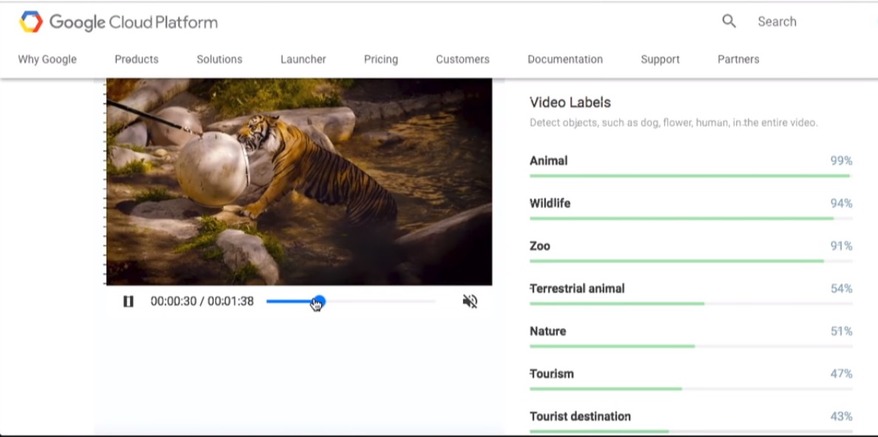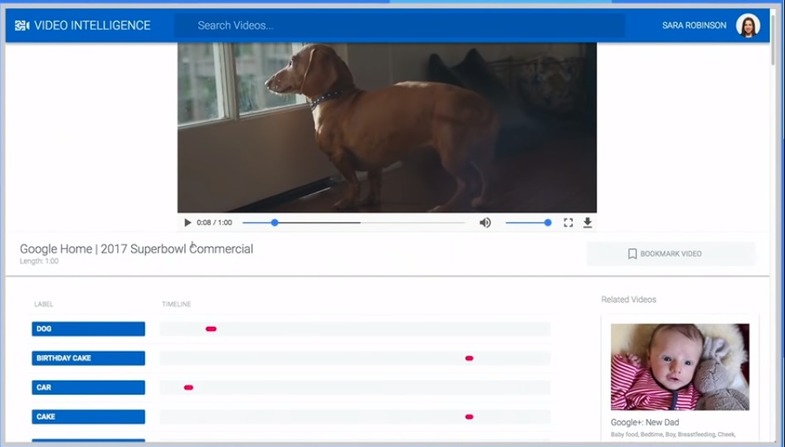Artificial Intelligence Applications using Google Video Intelligence API
Sanam Malhotra | 13th February 2020

Artificial Intelligence (AI) and its underlying Machine Learning (ML) technology have widened the scope of video analytics. Following the Mckinsey Global Institute research, video analytics applications are expected to witness a compound annual growth rate of over 50% by 2021. From media publishing houses to retail and security business models, AI-powered deep video analytics is poised to generate valuable insights for diverse settings. In today’s article, we are throwing light on the development of artificial intelligence applications using the Google Video Intelligence model. Find out how your business can harness the power of artificial intelligence services for performing in-depth video analysis for maximum customer engagement.
What is Google Cloud Video Intelligence API?
Google Video Intelligence API is a cloud-based machine learning service specially designed for analyzing stored and streaming videos. The model can automate the identification of diverse objects, places, and actions fro prodigious volumes of media data using metadata and video libraries.
Until now, machine learning algorithms were efficient at automating the recognition of objects and entities from stationary images. With artificial intelligence applications using Video Intelligence API, businesses can streamline video searches with the REST API for performing the following functions-
a) Identifying over 1000s of entities and activities like running, jumping, etc.
b) Recognizing inappropriate content or explicit videos
c) Detecting the instances of certain events in videos using shot change detection
d) Tracking objects and recognizing textual data from videos
e) Performing speech transcription in videos

Video labeling at play using Google Video Intelligence
With advancements in machine learning development services, Google Video Intelligence API extracts rich information from petabytes of data accurately. The model opens new opportunities for media publishers and Video On Demand business models such as-
a) Subscription-based video businesses like Netflix and HBO
b) Transactional video businesses like Google Play, iTunes, and
c) Ad-based video businesses
In the next section, we will take a closer look at how these businesses can deploy artificial intelligence applications using Google Video Intelligence.
Business Artificial Intelligence Applications Using Google Cloud Video Intelligence
1) Object detection and tracking
After achieving business-oriented results in object detection for digital images, Google’s Video Intelligence provides for an accurate framework for deep video analytics. The object tracking feature enables us to understand three things
a) On a high level, object tracking feature tells us what the video is about
b) On a granular level, it annotates the video with labels or tags to mark entities appearing in a video
c) Finally, it highlights the exact timestamp when a certain entity appears in the video timeline.

Video Intelligence Demo showcasing how the object tracking feature recognizes the entity “dog” and highlights its occurrence in red.
In addition, the annotations can include further entity information like the entity id to track the same entity in other videos.
Also read- Strengthening Enterprises with AI in Video Surveillance
2) Video Recommendation Engine
Web content recommendation has become a significant marketing strategy over the past few years. The advent of AI and ML technologies have accelerated and strengthened the recommendation systems across eCommerce and video-on-demand businesses.
Google’s Video Intelligence API is a step ahead of the current practices followed to develop content recommendation engines. The API’s recommendation engines are powered by accurate labels derived from the video footage. Here’s how artificial intelligence applications using Google Video Intelligence procure relevant content for maximum user engagement-
a) With the label analysis feature, the Video Intelligence API can identify objects, locations, activities, animal species, products, and more.
b) Businesses can combine the labels generated from the Video Intelligence API and users’ viewing history and preference data to build personalized recommendation engines.
Also read- How eCommerce can harness Deep Learning for Recommendation Systems
3) Content Filteration and Moderation
For organizations, content filtration is crucial for warding off objectionable web content essential for legal compliance and online reputation management. However, traditional filtration techniques are inefficient at handling an explosion of online data accurately and efficiently.
Artificial intelligence applications using Google’s Video Intelligence model enables organizations to not only eliminate but moderate video content easily. It can be done with the combination of safe-search feature in the Cloud Vision API and the explicit content detection functionality in Cloud Video Intelligence. The feature list under content filtration goes as such-
a) Explicit content detection performs filtration on a per-frame basis
b) The feature can be deployed using REST APIs, C#, Java, Go, Python, and other programming languages.
c) The model can be easily run across operating systems like Linux, macOS, and Windows.
Also read- Google Cloud AutoML for Machine Learning Solutions: Automation Exemplified
Deploying Artificial Intelligence Applications using Google Video Intelligence with Oodles AI
The explosion of video content has lead to a large scale expansion and adoption of deep video analytics. At Oodles, we are witnessing an exclusive demand for AI-infused solutions for video analytics for surveillance, recommendations, media publishing, and other business settings. The AI and ML development team at Oodles has experiential knowledge in building deep video analytics models delivering the following values-
a) Facial recognition for automated corporate attendance systems
b) Real-time object detection and tracking for intelligent production monitoring systems at manufacturing houses
c) Video content recommendation engines for retail and media publishing businesses
d) Accurate content filtration models for Edutech and child-care services
Our AI team deploys open-source ML libraries like TensorFlow and uses video processing techniques such as Histogram of oriented gradients and CNN. We offer deep video analytics services using third-party ML models such as Google Video Intelligence and Azure Video Indexer.
Discover our dynamic artificial intelligence services by reaching out to our AI development team here.



